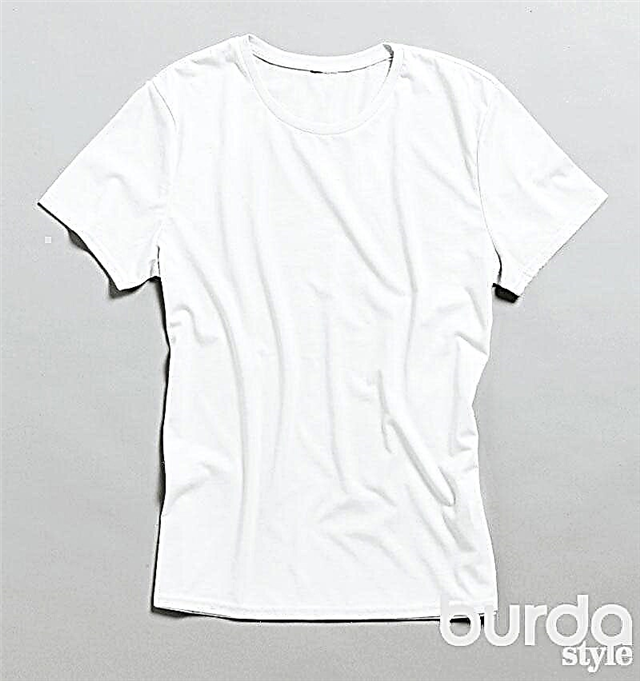Soft lines, beveled shelves and lowered sleeves - this jacket will easily fit into your everyday wardrobe. You can emphasize the waist thanks to the drawstring with a decorative cord.

A little time, a minimum of effort and you will get a universal thing that can be worn as a jacket, and as a lightweight jacket.
Almost any fabric that you like is suitable for this model.
In our examples in the magazine Burda Extra 4/2020 is a camouflage fabric for the casual option and plain fabric for a more classic style:
- New

- 1
- 2
- 3
- 4
You will need:
- fabric 1.65−2.05−2.10−2.20−2.45−2.55 m 140 cm wide;
- adhesive cushioning material (for example, interlining H 180);
- cotton cord 1.55-1.60-1.70-0.80-1.90-1.90 m;
- ribbons of twill weave 2.5 cm wide for a drawstring 1.65−1.70−1.90−2.05−2.30−2.40 m.
Cut
Reshape the details of the pattern and cut.
Important!
Copy separately the details of the pick-up 1a and the trim 2a from the parts of the front 1 and back 2 according to the lines indicated on the patterns.
For drawstring in this model we used twill weave.If you want to draw a drawstring from the fabric of the product, then you need to draw and cut the part directly on the fabric: 1 part 80–86–93–102–113–118 cm long and 2.5 cm wide.

Lay out the details of the paper pattern on the material in accordance with the layout plan.
Pin the details to the fabric.
Patterns do not include allowances for seam processing, therefore, it is necessary to add allowances for seams of the following width for all sections of parts:
2 cm - to the side sections of the front and back, 1 cm - to the remaining sections of the parts, 4 cm - allowance for the hem of the bottom of the product and sleeves.

Cut parts (with allowances for seams) from the fabric.
Apply all control marks, making short cuts on the sections of the parts in the appropriate places.
To put the lines specified on details and if necessary inscriptions and letter designations. To draw lines of seams (contours of patterns) using a special tailor's pencil on the wrong side of each part.
Apply drawstitch lines with copy stitches.

Duplicate with a gasket the back of the neckline 2a.
Sewing School: Duplication of Clothing Parts
How to duplicate the details of coats and jackets
Sewing
After grinding the parts, the seam allowances are sewn on the overlock or in a zigzag stitch.
Step 1. Key Details

Chop and grind the shoulder sections of the front 1 and back 2.
Step 2. Pick and Turn

Chop and grind the shoulder sections of the selections 1a and the back of the neck 2a.
Step 3

Trim the inner sections of the pick-ups / necklines on the overlock or zigzag stitch.
Fold the product and internal parts with their faces to each other and grind the neck, sides and lower corners of the sides.
Step 4

Trim the weld seam allowances to an unequal width.

Notch allowances for the weld seam in curly sections in several places, not reaching 2 mm to the stitch.
Step 5
Bend the pick / edge to the wrong side.
Straighten and iron the sharpened edges.

Attach the inner edges of the pick-ups / trim to the shoulder seams of the product from the wrong side.
Step 6. Sleeves

Stitch the sleeves in the armholes of the product from and to the lines of the lower sections of the sleeves, combining the control marks and slightly fitting the sleeve along the okat in its upper part, since the length of the cut of the sleeve okay is slightly greater than the length of the cut of the armhole.
Spread the excess cut length evenly so that no assemblies form.
Step 7
Bend the sleeves along the middle, fold in front and back with the front sides to each other.

Stitch the lower sections of the sleeves.
Step 8

Start side sections of the product.
Step 9

Iron the hem of the bottom of the sleeves with a width of 3 cm on the wrong side, pin and stitch.
Step 10

Iron the hem of the bottom of the product with a width of 3 cm to the wrong side, pin and stitch.
Step 11

Stitch the inner edges of the bows on the front, laying a line on the front of the product.
Step 12. Drawstring and Cord
Process the ends of the braid or the details of the drawstring with a seam in the hem.
Iron the longitudinal sections of the drawstring to the wrong side and sweep.

Stitch a braid or drawstring onto the product along the indicated lines to the edge on both sides.
Step 13

Thread the cord into the drawstring, tie the knots at the ends of the cord.

Done!
Life hack: how to use a tape to put the cord into the curtain
How to stitch a drawstring on a product
How to sew a drawstring tie
Source and photo: Burda Extra 4/2020



